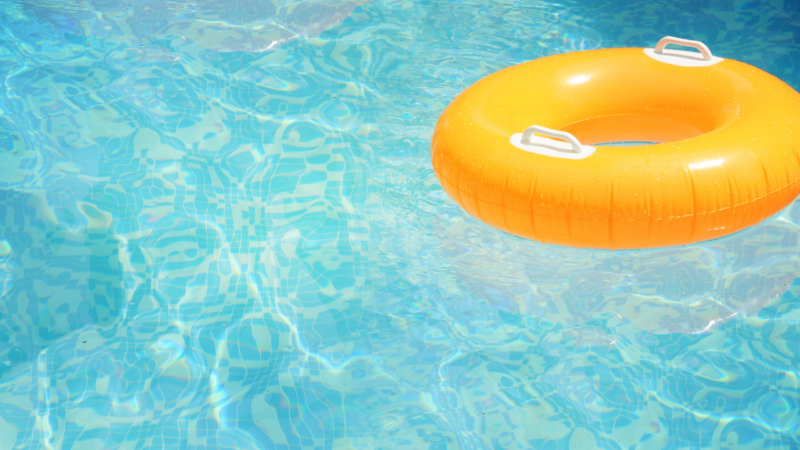Keep the Kids Safe: Pool Safety Tips for Families

As the summer months approach, many families take to the backyard and public pools to participate in refreshing recreational water activities. While swimming can serve as a beneficial physical activity for children, pool safety for kids should be a top priority for adults to ensure the safety of young ones in and around pools.
The Royal Life Saving Society Australia (RLSSA) reports that drowning is the leading cause of death for children under five in Australia. And for every drowning death, it’s estimated that 5-10 non-fatal drowning incidents occur, often leading to brain damage from lack of oxygen.
Parents and guardians can help prevent unfortunate pool-related accidents and injuries through proactive preparation and conscientious supervision. As a professional pool builder, here are some best practices I can advise parents and guardians to keep their children safe.
Supervise Children Actively
Number one rule – actively supervise the little ones whenever they’re swimming. Don’t just rely on older kids or lifeguards to keep watch. Make sure an adult has eyes on the children at all times.
Trade-off “water watcher” duties with other parents or caregivers so you can take the occasional breather.
Give your complete focus to the kids.
No answering phone calls, checking emails or getting distracted. They can disappear under the water in seconds if you aren’t diligent.
Here are some guidelines recommended:
- Keeping kids under five within arm’s reach at all times
- Even older children shouldn’t be left alone in the water
- If talking on the phone, move away from the pool area so you don’t get distracted
The danger can come quickly and quietly. Stay vigilant when supervising pool time.
Get a Free No Obligation On-Site Consultation Now
Please fill in your details below and we’ll get back to you.
Teach Kids to Swim
Start teaching kids to swim as early as possible. Swimming lessons can begin around six months old with a parent and instructor. By age 3-4, kids can start more formal group or private swim lessons.
The benefits of early swim lessons include the following:
- Getting kids comfortable in the water from a young age
- Teaching essential skills like floating, kicking, and basic strokes
- Reducing the risk of drowning by up to 88%, according to some studies
Look for instructors certified by AUSTSWIM, Australia’s national swim teaching program.
Kids who know how to swim are much safer in the water.
Set Pool Rules
Take proactive steps to outline and consistently reinforce swimming and poolside rules for children of all ages before the start of summer.
Verbal explanations should ensure genuine understanding.
Post visual rule reminders around the pool area for regular reference. Use pool signs, posters, or stickers.
Some basic ones include:
- No running on the pool deck. Running can lead to falls and injuries.
- No pushing or rough play in the pool. Pushing and rough play can cause someone to lose their balance and fall into the water.
- No diving in shallow areas – this can result in serious head injuries.
- Stay away from pool drains and suction outlets. Pool drains can trap children and cause drowning.
- Only swim when an adult is present. Adults can help to keep children safe by watching them closely, teaching them pool safety rules, and providing flotation devices when necessary.
- Do not play with toys that could get caught in pool drains. Toys can also trap children and cause drowning.
Learn CPR
Knowing CPR could save your child’s life in a pool emergency. Take a first aid and CPR class from the Red Cross or another provider. Red Cross offers both online and in-person courses.
Keep CPR instructions visible near the pool area – on the fence or wall.
Review the steps regularly with your family.
Teach kids the basics of hands-only CPR.
In an emergency, start CPR immediately and have someone call 000 for help.
Precious minutes count when a child is submerged underwater.

Provide Safety Gear
Have kids wear life jackets or personal flotation devices if they aren’t strong swimmers yet. Choose vest-style jackets over inflatable water wings. Check flotation devices for rips, tears, and proper fit. Replace items as needed each season.
Install a phone outside the pool fence with emergency numbers posted for backyard pools to eliminate delays if you need to call for help.
Keep a first aid kit filled with bandages, gauze, antiseptic wash and other basic supplies poolside.
Know how to prevent and treat pool-related injuries like abrasions, sunburns, and dehydration.
Watch For Danger Signs
Pay attention to pool-related problems that could put children at risk:
- Missing or broken fencing, gates, latches, and locks
- Pools filled up with rainwater and became murky, hiding the bottom surface
- Missing drain covers and broken or loose drain fitting
- Worn pool liners, especially tears that can trap small fingers or toes
- Broken ladders, handrails, slides, and diving boards
Take kids out of the pool immediately if you notice electrical problems, like sparks or power failure. Don’t allow swimming during electrical storms.
Check the pool chemicals too. Improperly treated water can lead to toxic gas build-up, slippery surfaces, and diluted chlorine levels.
Know What To Do In An Emergency
Even with all the right precautions, pool emergencies can still happen. Here’s what to do if a child is in distress:
1. Yell for help. Instruct someone to call 000 immediately.
2. Pull the child from the water if it’s safe to reach them. Use Shepherd’s Crook or reaching pole if needed.
3. Start CPR right away if the child is unresponsive. Open the airway with a head tilt and chin lift. Give two rescue breaths, then start cycles of 30 chest compressions and two breaths.
4. Keep performing CPR until emergency crews arrive. Don’t stop except in case of vomiting, then roll them to the side.
5. Comfort and talk to conscious kids after rescue. Monitor breathing closely.
6. Seek medical evaluation, even if they seem fine. Delayed symptoms may appear.
Get a Free No Obligation On-Site Consultation Now
Please fill in your details below and we’ll get back to you.
Take Pool Safety Classes
Look for water safety courses in your local area to stay up-to-date on the latest recommendations. The Royal Life Saving Society offers several programs:
- Keep Watch teaches pool supervision for parents and carers
- Grey Medallion teaches adults crucial water safety and lifesaving skills for aquatic activities
- Bronze Medallion is a beginner lifesaving course
Additional Pool Safety Tips
- Set physical barriers like fencing with a self-latching gate for backyard pools – this prevents unsupervised pool access.
- Keep the pool covered when it’s not in use. A pool cover can help prevent children from accessing the pool alone.
- Install a pool alarm. A pool alarm can alert you if someone enters the pool.
- Check local regulations – many councils require fencing for residential pools over 30 centimetres deep.
Conclusion
As you can see, there are many important considerations for ensuring pool safety for kids. With proper supervision, precautions, and preparedness, you can have peace of mind knowing your children can safely enjoy the water.
If you want to build a new pool or upgrade an existing one, contact us here at Wagtail Built. Our team of expert pool builders can help design and construct a pool tailored to your family’s needs with the latest safety features in mind.
We offer complimentary consultations to discuss your vision and budget. Please contact us to learn more about our full range of new pool construction and renovation services.
Most importantly, we hope this guidance is useful for planning an accident-free summer of fun pool memories with your loved ones.





